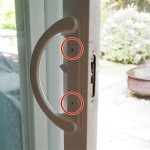How To Remove A Patio Screen Door From The Track And Frame
A patio screen door, while seemingly a simple component, plays a crucial role in allowing fresh air into a home while keeping insects out. However, there are various reasons why one might need to remove a patio screen door. These reasons range from simple cleaning and maintenance to more complex tasks such as repair, replacement, or even adjusting the door for smoother operation. Understanding the process of removing a patio screen door safely and effectively is essential for homeowners undertaking these tasks. This article presents a comprehensive guide on how to remove a patio screen door from its track and frame, outlining the necessary steps and precautions to ensure a successful removal process without causing damage to the door or the surrounding structure.
Before starting the removal process, it's important to assess the type of patio screen door and its locking mechanism. Screen doors come in various designs, including sliding, hinged, and retractable models. Sliding screen doors are the most common type in residential settings. Furthermore, understanding how the door is secured within the track and frame is critical. Some doors rely solely on their roller wheels to maintain their position, while others incorporate locking mechanisms that need to be disengaged before removal. Identifying these features will streamline the removal process and prevent potential complications.
Safety should always be a primary concern when undertaking any home repair or maintenance project. Before attempting to remove a patio screen door, it is advisable to wear appropriate safety gear. This includes gloves to protect hands from sharp edges or splinters and eye protection to shield eyes from dust and debris. It's also important to have a clear and unobstructed workspace to avoid tripping hazards. Furthermore, if the screen door is particularly large or heavy, consider enlisting the help of another person to prevent accidental drops or injuries.
Preparing for Screen Door Removal
The first step in removing a patio screen door involves preparing the surrounding area. This includes clearing any furniture or obstacles that might impede movement around the doorway. Additionally, ensure that the track is free of debris such as dirt, leaves, or small objects. Using a brush or vacuum cleaner to clean the track will make it easier to maneuver the door during the removal process. Inspect the track for any signs of damage or wear, as this might affect the door's movement. Addressing any track issues before attempting to remove the door can prevent further complications.
Next, carefully examine the patio screen door itself. Look for any visible screws, clips, or locking devices that secure the door to the frame or track. These fasteners must be disengaged or removed before the door can be lifted out. Some screen doors have spring-loaded plungers or rollers that need to be depressed or adjusted. Identify the location and function of these components to avoid damaging them during removal. If the door has a locking mechanism, ensure that it is in the unlocked position before proceeding. Failure to do so could result in damage to the locking mechanism or the frame.
If the screen door has adjustable rollers, now is the time to lower them as far as they can go. These rollers are typically located at the bottom corners of the door, and they allow for height adjustments to ensure smooth sliding. Lowering the rollers provides more clearance for lifting the door out of the track. To adjust the rollers, look for small adjustment screws located near the rollers. Use a screwdriver to turn the screws counterclockwise to lower the rollers. Make sure to adjust both rollers equally to maintain the door's balance. If the rollers are corroded or difficult to turn, apply a small amount of penetrating oil to loosen them before attempting to adjust them.
Gather the necessary tools for the job. While the tools required may vary depending on the type of patio screen door, some common tools include a screwdriver (both flathead and Phillips head), a putty knife or thin pry bar, and a pair of gloves. A step stool might also be useful if the door is particularly tall. Having these tools readily available will streamline the removal process and prevent unnecessary delays. Ensure that the tools are in good working condition and that the screwdriver heads match the size and type of screws used in the door frame.
Removing the Screen Door
With the preparation completed, the next step is to remove the patio screen door from its track. This process typically involves lifting the door up and out of the lower track. Start by positioning oneself on the side of the door that allows for the easiest access to the rollers and the upper track. Grip the door firmly with both hands, ensuring a secure hold. Apply gentle upward pressure to lift the door slightly. The goal is to disengage the rollers from the lower track, allowing the door to be tilted inward.
Once the rollers are disengaged from the lower track, tilt the top of the door towards oneself. This will allow the top edge of the door to clear the upper track. Continue lifting and tilting the door until it is completely free from both tracks. Be careful not to force the door, as this could damage the tracks or the door itself. If the door is particularly heavy or difficult to maneuver, ask for assistance to prevent accidents. Keep the door level during removal to prevent it from twisting or bending.
If the screen door has a latch or locking mechanism that extends into the frame, it may be necessary to manipulate this mechanism to fully disengage the door. Use a screwdriver or other tool to gently push the latch back into the door while lifting and tilting. Be careful not to damage the latch or the frame. If the latch is particularly stubborn, try applying a small amount of lubricant to loosen it. Once the latch is disengaged, the door should lift out easily.
Some patio screen doors are equipped with anti-lift devices that prevent them from being easily removed. These devices are typically located at the top of the door and engage with the upper track. To remove a door with an anti-lift device, it may be necessary to slide the door to a specific position where the device is disengaged. Consult the door's instruction manual or manufacturer's website for specific instructions on how to disengage the anti-lift device. Attempting to force the door without disengaging the device could result in damage to the door or the track.
Post-Removal Procedures and Considerations
After successfully removing the patio screen door, it is important to inspect the door and the track for any signs of damage or wear. Check the rollers for cracks, corrosion, or other damage. Replace any damaged rollers to ensure smooth operation when the door is reinstalled. Examine the screen mesh for tears or holes. Repair or replace the screen as needed to prevent insects from entering the home. Clean the door frame and track to remove any dirt or debris. Lubricate the track with a silicone-based lubricant to promote smooth sliding.
If the screen door was removed for cleaning or repair, now is the time to address these tasks. Use a mild detergent and water to clean the door frame and screen mesh. Rinse thoroughly and allow the door to dry completely before reinstalling it. For screen repairs, use a screen repair kit to patch any holes or tears. If the screen is severely damaged, consider replacing the entire screen mesh. When handling the screen mesh, wear gloves to protect your hands from the sharp edges of the mesh.
If the patio screen door was removed for replacement, dispose of the old door properly. Contact the local waste management authority for information on how to dispose of large items. Some recycling centers may accept aluminum or metal screen doors. Avoid leaving the old door in a public area, as this could pose a safety hazard. If the door is still in usable condition, consider donating it to a local charity or organization that accepts used building materials.
Store the removed patio screen door in a safe and secure location until it is ready to be reinstalled or disposed of. Lean the door against a wall in a garage or shed to prevent it from falling over. Cover the door with a tarp or sheet to protect it from dust and debris. If the door is being stored for an extended period of time, consider removing the rollers to prevent them from becoming damaged or corroded. Label the door clearly to identify it and prevent confusion with other doors or screens.
Finally, remember that reinstallation is essentially the reverse of the removal process. Ensure all rollers are properly adjusted, the track is clean and lubricated, and any locking mechanisms are functioning correctly before fully securing the door. If any difficulties arise during reinstallation, review the steps outlined in this article and consult the door's instruction manual or a professional for assistance.

How To Remove A Sliding Screen Door 9 Steps With S

How To Remove A Sliding Screen Door 9 Steps With S

How To Proper Removal Replacement Of Sliding Glass Door Screen

How To Put A Sliding Screen Door Back On Track Frontdoor

How To Remove And Reinstall A Screen On Vinyl Sliding Patio Door

How To Remove Sliding Glass Doors Diy Guide Action

How To Remove A Sliding Screen Door 9 Steps With S

How To Fix A Sliding Screen Door Apex Window Werks

How To Replace The Screen On A Door 11 Steps

How Can I Remove My Pella Sliding Door From The Frame Swisco Com








